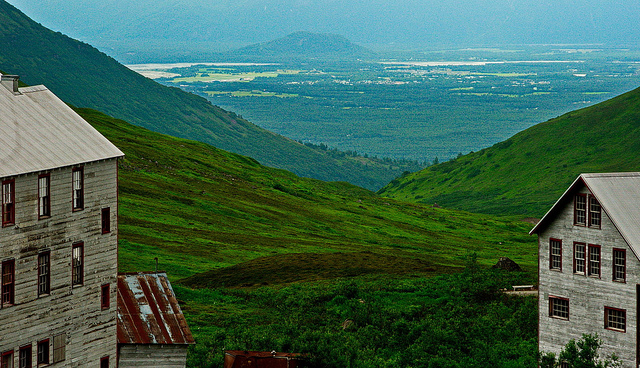
View from Independence Mine in Hatcher Pass. Photo © Dave Bezair & Susi Havens-Bezaire, licensed Creative Commons Attribution Share-alike.

Anchorage and Vicinity
It’s hard to imagine a park that better combines the elements of the Alaska experience: scenery, history and lore, and that noble yellow metal, gold. This mine is very different from the panning, sluicing, deep-placer, and dredging operations seen in Interior Alaska. This was “hard-rock” mining, with an intricate 21-mile network of tunnels under Granite Mountain. The miners drilled into the rock, inserted explosives (which they set off at the end of shifts to give the fumes time to dissipate before the next crew went in), then “mucked” the debris out by hand, to be sorted, crushed, amalgamated, and assayed.Hard-rock or “lode” mining is often preceded by panning and placer mining. Prospectors who first took gold from Grubstake Gulch, a tributary of Willow Creek, in 1897 noticed the gold’s rough unweathered nature, which indicated a possible lode of unexposed gold nearby. In 1906, Robert Lee Hatcher staked the first lode claim, and his Alaska Free Gold Mine operated until 1924. In 1908 the Independence Mine opened on the mountain’s east slope, and over the next 25 years it produced several million dollars’ worth of gold. In 1937 the two mines merged into the Alaska Pacific Consolidated Mining Company, which operated Independence Mine at peak production through 1942, when World War II shut it down. A series of private sales and public deals with the Alaska Division of Parks culminated in 1980, leaving the state with 271 acres, including the whole mining camp, and deeding 1,000 acres to the Coronado Mining Corporation, which has active operations in the area.
A couple of dozen camp buildings are in various stages of ruin and refurbishing. Start at the visitors center in the rehabilitated house of the camp manager. Take some time to enjoy the excellent displays: historic charts, an overview of gold mining, a “touch tunnel” complete with sound effects, and wage summaries for workers and management. Guided tours ($5) are given daily at 1 and 3 p.m. by park personnel. At other times, just wander the site on your own; interpretive signs describe the various buildings. Independence Mine State Historical Park is a must-see on any Alaskan itinerary.
The visitors center (907/745-2827 summer only or 907/745-3975, parking $5) is open daily 11 a.m.–6 p.m. late May–early September, and closed the rest of the year.
Excerpted from the Tenth Edition of Moon Alaska.